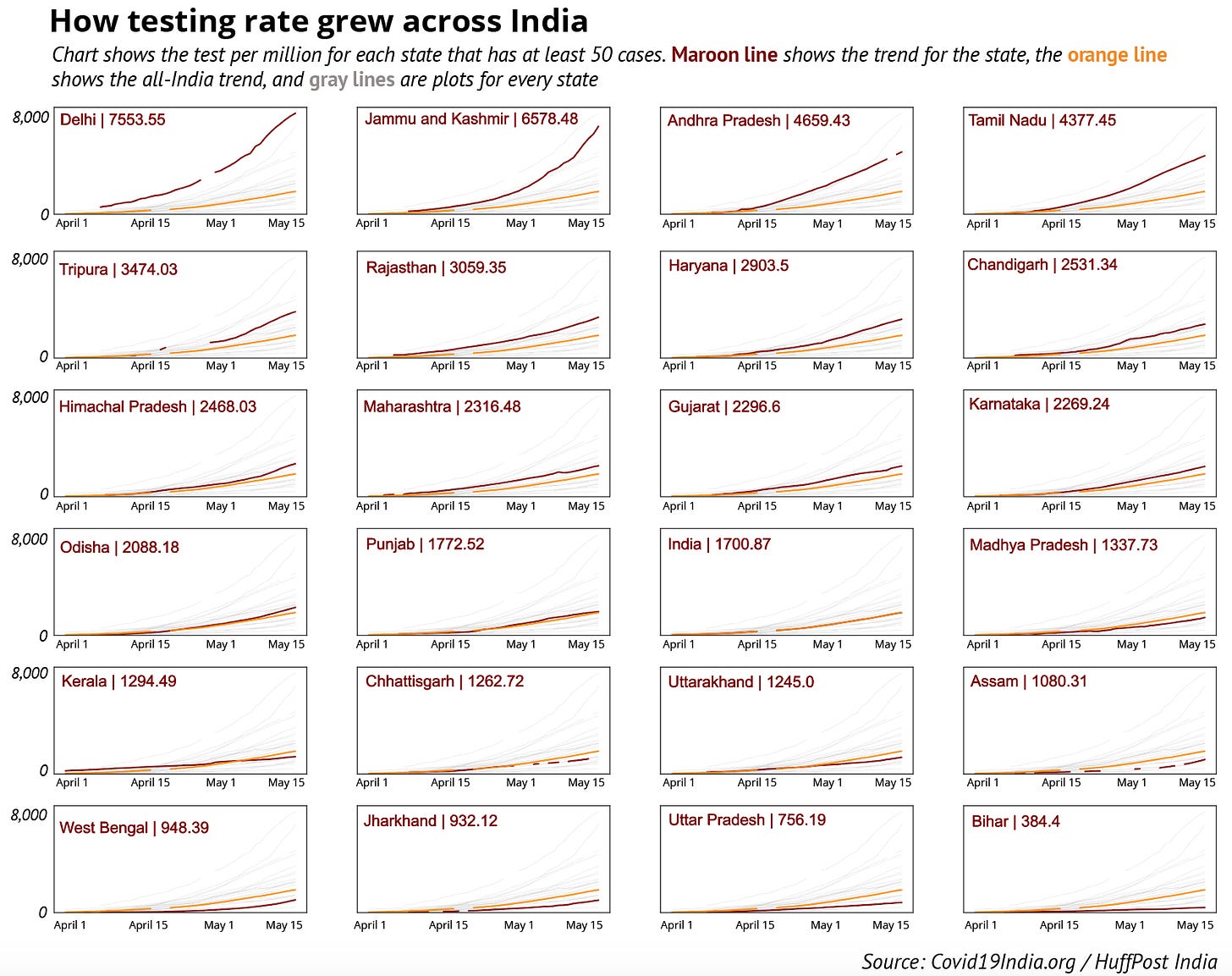DisFact: Meaningless COVID-19 data. ICMR's procurement screw-up. Aarogya Setu.
COVID-19 reportage
Hello there,
Hope you are keeping well.
I started reporting on COVID-19 for HuffPost India in the last week of April. It’s challenging.
For one, the uncertainty around the virus is huge. There are so many interconnected parts moving together and interacting in complex ways that figuring out what’s going on is hard. It’s also a bit difficult to speak with people within the system—I mean, people who will give you the complete inside picture. Some are not responding because they have clear instructions not to talk to the press; some are just so busy dealing with the crisis that they—quite obviously—can’t find the time to entertain requests from a journalist. When you do get across that insider who shares valuable information, it becomes quite a task to corroborate that with other sources. If you can’t, the notes remain stuck at the Editor’s desk.
To be sure, these are regular reporting challenges—and rigorously dealing with them is what makes journalism different from tweeting a quick hot take. It’s just that these are not normal times.
I am linking to three articles I wrote in May: two reported stories and one opinion piece on my personal blog. As always, critical feedback is most welcome.
A request: If you have any stories, ideas or tips to share with me, my inbox is always open for you. I will be grateful if you do. Anything from spread of COVID-19 in your neighbourhood to treatment at nearby hospitals, changes in the workplace or trends that you are observing—anything. This is a shared experience for all of us and hearing from you will only help me do my work better. Do consider.
Indian Govt Trots Out Meaningless Data As COVID-19 Cases Rocket Despite Lockdown

I started writing a story to look at what data is telling us about the pandemic in India. I analysed publicly available data, information in local health bulletins, read government documents and interviewed district and state-level officials, and infectious disease experts to understand what coronavirus statistics actually reveal.
My conclusion: not much. My reporting suggests that the imperfect COVID-19 are numbers at best, offering an underestimate of the coronavirus’s spread, and at worst, forming the basis for misleading conclusions to support arbitrary policy decisions.
You can read my story in HuffPost India. It’s a long read, with analysis and micro case studies from states and districts, which I use to illustrate the larger problems with the numbers. I summarized key points in a Twitter thread.
Test Kit Shortage: ICMR's Crucial Mistakes Wasted India's Lockdown

If you did not follow the ICMR’s antibody kit fiasco, let me set the context before your read this piece.
Broadly, there are two types of COVID-19 tests: RT-PCR tests and rapid antibody tests.
Rapid tests are blood-based tests that take less than 30 minutes to detect the novel coronavirus compared to 8-9 hours that the lab-based RT-PCR test takes. The key difference between the two: RT-PCR test looks for the virus. Rapid kits look for antibodies developed in response to the virus.
Manufacturers and public authorities—including ICMR—have repeatedly asserted that rapid kits only serve the purpose of monitoring and surveillance, not diagnosis. Only the RT-PCR test can serve as a confirmatory diagnostic test.
But RT-PCR tests requires lab infrastructure, trained manpower and imported machines, meaning scaling it up to increase testing takes time. That’s why states started looking at rapid testing and requested the centre to issue guidelines on its usage in March. Eventually, ICMR placed initial orders for rapid test kits on 27th and 28th March, and issued first guidelines on 4th April.
As of early May, ICMR had floated tenders for at least 6.5 million rapid diagnostic kits since March 2020, of which, the only kits that arrived (as of May 3, when we published the story) was the ill-fated consignment of 500,000 Chinese kits, which ICMR refused to pay for. That’s because (a) states complained that the kits didn’t work (b) a commercial dispute in the court revealed that ICMR agreed to pay Rs 600 for tests that actually cost only Rs 245.
ICMR failed in procuring rapid kits. However, some state governments have proved to be much better at securing these supplies. What went wrong? We explored that in this HuffPost India report.
The story lookes at supply-chain issues in ramping up COVID-19 testing. Getting medical supplies is not just about spending money. Procurement is a skill, and events of April show ICMR is not good at it.
Confused about Aarogya Setu? Here is a guide to think about your privacy
Many are concerned that Aarogya Setu, India’s contact tracing app, is a privacy disaster, a mass surveillance project masquerading as a tool for public health interventions. The privacy concerns are obvious: the purpose of the app is to track you. It asks you for the most sensitive information that a smartphone can collect: your location.
Despite all that, I think we are missing on the nuance on privacy concerns.
In this post on my personal blog, I described the process I used to decide if and how I should use the Aarogya Setu app—despite all the privacy concerns.
Look, there aren’t simple yes/no answers to the question “will this technology violate my privacy?” You need to ask specific questions to understand what data we want to protect, from whom, the risks of failing to protect it, the likelihood that it needs to be protected, and assess the trouble we are willing to go through to protect our information. Being more specific can help you make informed decisions. Read this for the framework I used—not for my conclusion.



